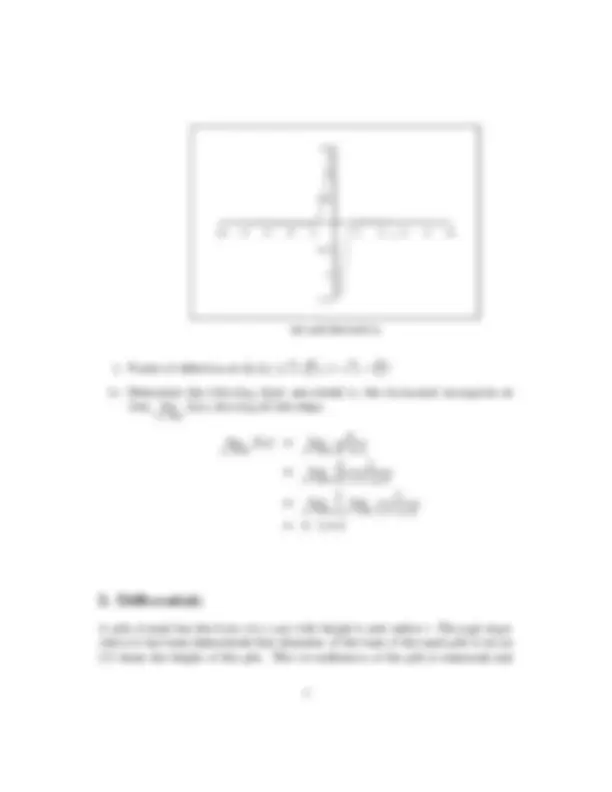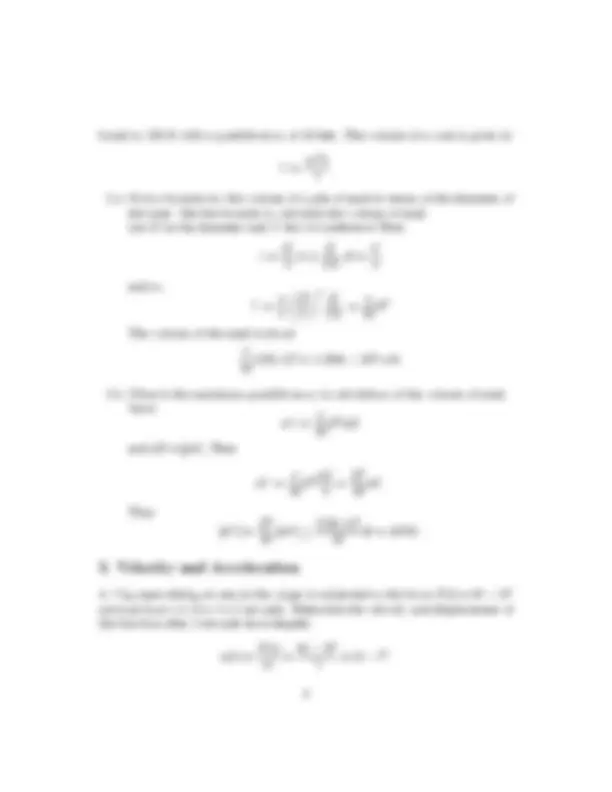






Study with the several resources on Docsity

Earn points by helping other students or get them with a premium plan


Prepare for your exams
Study with the several resources on Docsity

Earn points to download
Earn points by helping other students or get them with a premium plan
Community
Ask the community for help and clear up your study doubts
Discover the best universities in your country according to Docsity users
Free resources
Download our free guides on studying techniques, anxiety management strategies, and thesis advice from Docsity tutors
The solutions to test #4 in a calculus i course. Topics covered include curve sketchting of a function, finding extrema and points of inflection, calculating limits, finding the volume of a cone, determining velocity and acceleration, and optimizing the dimensions of a wooden beam. The document also includes the use of maple for finding derivatives and graphs.
Typology: Exams
1 / 8

This page cannot be seen from the preview
Don't miss anything!





1.a Sketch the graph of f (x) = (^) x 2 x+1 , showing the maxima, minima, inflection points, and horizontal asymptotes. You may use Maple to find the graph, and the first and second derivatives.
-0.
-0.
0
-10 -8 -6 -4 -2 (^2 4) x 6 8 10
1.b What equations did you solve to find the extrema, and the points of inflec- tion? f^0 (x) = d dx
μ x x^2 + 1
1 − x^2 (x^2 + 1)^2
Set
1 − x^2 = 0 x = − 1 , 1 f(x) = −
0
1
-10 -8 -6 -4 -2 (^2 4) x 6 8 10
derivative
min at (− 1 , −^12 ),max at (1, 12 )
f 0 0 (x) = d dx
μ 1 − x^2 (x^2 + 1)^2
= 2x x^2 − 3 (x^2 + 1)^3
Set
x
x^2 − 3
x = 0 ,
f(x) = 0 ,
found to 325 ft with a possible error of 10 feet. The volume of a cone is given by
πr^2 h 3
2.a Give a formula for the volume of a pile of sand in terms of the diameter of the base. Use the formula to calculate the volume of sand. Let D be the diameter and C the circumference Then
r =
, h =
π and so V = π 3
μ D 2
π 30
The volume of the sand is about π 30
(325/π)^3 = 1. 1594 × 105 cu.ft.
2.b What is the maximum possible error in calculation of the volume of sand. Since dV = π 10 D^2 dD
and dD = (^) π^1 dC, Then
dV = π 10
dC π
dC.
Thus |dV | =
|dC| ≤ (325/π)^2 10
A 3 kg mass sitting at rest at the origin is subjected to the force F (t) = 6t − 3 t^2 newtons from t = 0 to t = 2 seconds. Determine the velocity and displacement of the function after 2 seconds have elapsed.
a(t) = F (t) m
6 t − 3 t^2 3 = 2t − t^2.
Then v(t) =
a(t)dt =
2 t − t^2
dt = t^2 −
t^3 + C,
and
0 = v(0) = 0 + 0 + C, C = 0 , so v(t) = t^2 −
t^3.
Next
s(t) =
v(t)dt =
Z μ t^2 −
t^3
dt =
t^3 −
t^4 + C
and
0 = s(0) = 0 + 0 + C, C = 0 , so s(t) =
t^3 −
t^4.
We were asked for v(2) = 4 − 83 = 43 , and s(2) = 83 − 1612 = 43 = 43. The graphs are:
0
1
0.2 0.4 0.6 0.8 (^1) t 1.2 1.4 1.6 1.8 2
A wooden beam has a rectangular cross-section of height h and width w. The strength S of the beam, measured in appropriate units, is 200 times the product
and h =
Aletrnative.Let θ the acute angle between a horizontal radius and the radial line from the centre of a beam and a corner. Then
w = 24 cos θ, h = 24 sin θ.
Thus
S = 200 (24 cos θ) (24 sin θ)^2 = 2764 800 cos θ sin^2 θ
Here is the graph
0
00000
00000
00000
00000
1e+
0.2 0.4 0.6 0.8 1 1.2 1.
Taking the derivative of S we get
dS dθ
d dθ 115 200 cos θ sin^2 θ = 345 600 cos^2 θ sin θ − 115 200 sin θ 115 200 (sin θ)
3 cos^2 θ − 1
We must chose
cos θ =
, sin θ =
and so
w = 24
h = 24